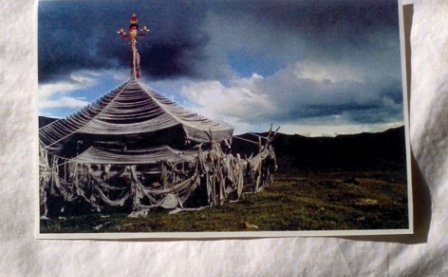“Ulaan” (or sometimes “ulan”) is a Mongolian word that means “red.” The word emerges often in Mongolian place names. Sometimes it’s a product of Soviet convention, like the name of the Mongolian capital, Ulaanbaatar, or “Red Hero,” a city invaded and renamed by the Soviets in 1924. And there’s Ulan-Ude, in Siberia, some 350 miles to the north of Ulaanbaatar, a Buryat city, renamed by the Soviets in 1934. The city hosts a conspicuous statue of Lenin’s head in the center of the main square. It’s 25 feet tall and 42 tons, and when it snows, it looks like Lenin is wearing a little yarmulke, so locals call it “the world’s biggest Jewish head,” or so I have read.
Then there are the natural reds: Ulaan-Uul, or “Red Mountain,” a remote northern district populated largely by Darkhads, Mongolian untouchables; or Ulaangom, “Red Sand,” a town off the Siberian border near Uvs Nuur, a lake five times saltier than the ocean. Red in nature can be liminal, like the sun setting against the steppe, or encompassing, like a dull winter sky.
That these “ulaans,” the imposed and the adopted, can exist side by side is a kind of accidental lesson in just how much historical and symbolic freight one little word can carry. Sometimes a name can be natural and fully possessed; sometimes it’s forced and awkward. If we didn’t take a second look, we might never know the difference.
Guitarist Steven R. Smith adopts the word for some of his solo projects, which he has released under the names Ulaan Passerine, Ulaan Markhor, and Ulaan Khol. All of the “Ulaan” projects are anchored by Smith’s roiling guitar, though the Ulaan Khol albums, of which there are six, are the most minimalist — suites of layered, distorted guitar and organ. (He has also released brooding eastern folk under the name Hala Strana — possibly my favorite of all his output — and a litany of other projects under different names.) Salt reminds us that the guitar has a capacity to undergird itself, to be sturdy and structural, while also retaining a kind of questing energy. Here, Smith’s structures are driven forward, becoming linty with guitar or synth noise, the way dirt might accumulate on a 1992 Nissan Sentra during a long drive through the Altais.
You might also think of each piece like a landscape painting. Smith creates idealized, emotional landscapes, full of an impressionistic inner movement but fundamentally detached, amoral. “Tree Herding” is centered on a spindly guitar figure, hard like a dense old tree, limbs hanging down scratching at the dirt; then a low wash of synth rolls in, eventually swallowing up the weeping tree and, we imagine, the rest of a long strand. Smith’s lead playing on “In the Spires” is bluesy and meandering, not so much emulating the human voice as the sting of the wind or the collapse of the spires of the title, as the light cuts through the walls, the descending organ chords narrating the eventual earthward plunge. “From Here to There” chugs along on a bluesy acoustic riff like a montage in a motorcycle movie; “Even the Stars Are Damned” never meets up with its doomsaying title but settles in, cozy, as if the stars tucking into their sockets rather than tumbling down to hell. There’s nothing sinister about it, unless you count wrestling in the dirt with Hendrix’s ghost.
Smith also visits the terrain of Neil Young and Thurston Moore (the way every landscape painter, perhaps, finds themselves treading on or around the same ground as Rembrandt and Monet). But these are familiar colors now by a natural process of dilution, easy on the eyes. “From Here to There” drives us somewhere, but nowhere we haven’t already been. The album’s most surprising moment is when the final track, “Purifoy,” segues into a “cover” of Leon Russell’s “Delta Lady” — just that chorus lick, straight descending blues, swinging like rock & roll, blasting the dust from the hood. But it’s the one minor twist on a path that’s for the most part unchallenging. I long for Smith, after six records, to engage deeper with his palette. After all, even an element as primary as the color red can play host to opposing meanings, even as points on the same map — is it red like a flag or red like a mountain? It’s never really just a color, something pretty, signifying something far off and foreign. Smith doesn’t go digging for the nuances that complicate meaning; the prettiness of Salt, ultimately, is only canvas deep.
More about: Hala Strana, Steven R. Smith, Ulaan Khol, Ulaan Markhor, Ulaan Passerine




